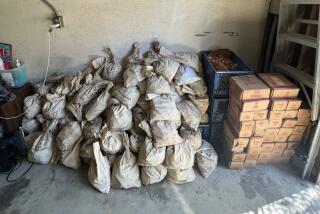Double-Die Wheat Cents Have Substantial Value
- Share via
Question: I came across your column last week accidentally, having heard from a friend that a 1-cent 1955 with a wheat design is rare. I would appreciate very much if you can tell me exactly what it’s worth.--E.C.M
Answer: Your friend may be right about the 1955 cent; then again, maybe not.
What your friend is probably referring to is the ’55 doubled-die variety, an oddity that commands a premium because of its peculiarity and relatively low mintage. However, if your ’55 cent is a regular circulated issue, then chances are it’s just worth face value or perhaps slightly more.
The trick concerning the ’55 cent is with the doubling. According to David L. Ganz and his book, “The World of Coins and Coin Collecting,” the problem occurred during production. “In the process of producing the dies for the 1-cent coin,” he says, “the working die was hubbed twice, or created by a transfer from positive to negative image, so that the lettering and date were not properly aligned. The result is a very obvious doubling of the letter and year of production.”
Ganz and Sol Taylor (in his “Standard Guide to the Lincoln Cent”) estimate that only 20,000 such doubled coins were produced. Since about 1 billion cents were issued from the various mints in 1955, you can see where 20,000 is a relatively small number. The “wheat back” design was changed in 1959 to the now familiar Lincoln Memorial reserve, but that is not a factor in pricing.
If your cent is a doubled-die error, it’s worth $150 and up. If not, you might as well spend it.
Q: I have quite a collection of coins from different countries--Israel, the United States--in silver and a few in gold. I would like to sell the entire lot to a dealer. I would appreciate a list of such buyers.--L.J.M.
A: There are many dealers who would be interested in your coins. From your standpoint, you want to realize the maximum profit potential.
Selling coins is not the easiest thing to do, but it can be done in a systematic and businesslike manner. First, list your coins by country, date and denomination. If you know the condition, so much the better. There are many price guides available, but they are just what the term implies-- guides. Still, it would be a good idea to locate several guides to get an idea of what your coins may be worth.
Next, contact several dealers. Many are listed in telephone directories. Many advertise in coin publications. Some undoubtedly are in your neighborhood. Your coins probably will have to be seen to be evaluated. Ask the dealers to quote prices for individual coins and for the entire collection.
I think you’ll find, after talking to several dealers, that offers will vary. Don’t sell until you believe you’ve received a fair offer. Remember, it will probably have little to do with catalogue value. Dealers buy wholesale, sell retail, and pricing guides are usually based on retail prices.
Coin News
Canada is issuing its 1990 commemorative dollar (pictured), marking the 300th anniversary of Henry Kelsey’s exploration of the Canadian prairies. Kelsey, depicted by artist David Craig, is believed to be the first white man to observe a buffalo. The obverse offers the first look at a contemporary portrait of Queen Elizabeth II, the first designed by a Canadian artist, Dora dePedery-Hunt, for use on a Canadian coin. The 1990 commemorative dollar is 50% silver, 50% copper. Prices are $19.50 for a proof $1, $14.60 for an uncirculated $1, $41 for a proof set, $15.50 for a specimen set, $7.40 for an uncirculated set; there is a $4 handling charge. Order from the Royal Canadian Mint, Box 457, Station A, Ottawa, Ontario (K1N 9H3; or telephone (800) 267-1871, Ext. 873.

